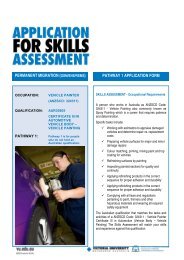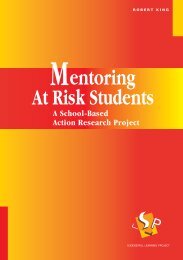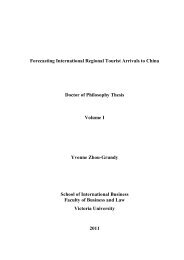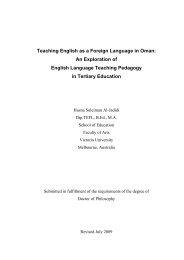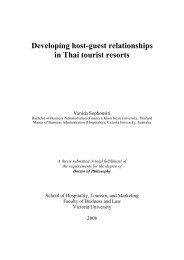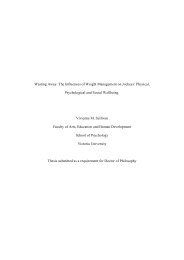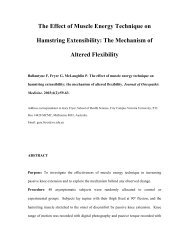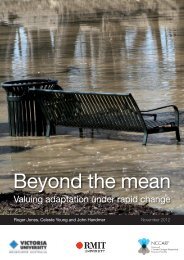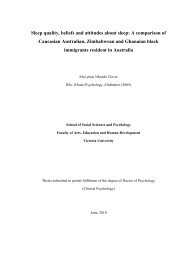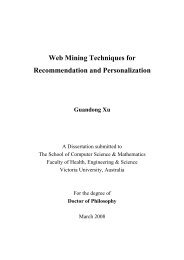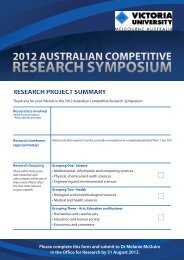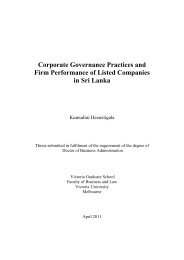Providing Education and Training for At Risk ... - Victoria University
Providing Education and Training for At Risk ... - Victoria University
Providing Education and Training for At Risk ... - Victoria University
- No tags were found...
Create successful ePaper yourself
Turn your PDF publications into a flip-book with our unique Google optimized e-Paper software.
We will develop some of these points <strong>for</strong>thwith, <strong>and</strong> return to these authors later in this Review.Another significant survey of research appeared in the same year as the above. Barr <strong>and</strong> Parrett(1995) identify <strong>and</strong> schematise effective programs right across schooling from infants toadolescents, <strong>and</strong> right across the United States. Amidst all the detail that such scope inevitablyentails, Barr <strong>and</strong> Parrett state:Students who fail in traditional classrooms have often been found to be very successfulin instructional programs that allow them to work at their own pace, focus on their owninstructional needs, use incentives <strong>for</strong> learning, <strong>and</strong> use teachers as facilitators….Suchindividualised, personalised learning has long been designed <strong>and</strong> available <strong>for</strong> specialeducation students. We now recognise that it is also essential <strong>and</strong> effective <strong>for</strong> at-riskyouth. (59-60)Barr <strong>and</strong> Parrett also have their list. They call it ‘What We Know About Effective Programs’(1995:Ch5). Amongst much detail, one illuminating research finding they quote, from the<strong>University</strong> of Wisconsin at Madison, which perhaps sums up their list, is that ‘the key findingof our research is that effective schools provide at-risk students with a community of support’(1995:55).In what follows, Australian research evidence (some of it anecdotal) not included in the above,because it has appeared since, is discussed. The Review will attempt to build up the evolutionof the notion of ‘alienation’, first, by analogy (Section 2), then by synthesis (Section 3). Itmust be stated at the outset that ‘alienation’ is, in this Review, a heuristic device. It enables usget where we want to go. For reasons soon to be made clear, it cannot be entertained as anadequate conceptualisation of young people facing challenges in returning to studies. Thelatter half of the Review discusses some implications <strong>for</strong> both the nature of the learning involvedin good programs (Section 4), <strong>and</strong> also the nature of the institutions that provide that learning(Section 5). A conclusion (Section 6) will identify a list of principles <strong>for</strong> effective programs,which the project as a whole will thereafter use in the fieldwork.Analysing AnalogiesAlienation is a larger concept than a focus on those who are ‘at risk’ of leaving schoolbe<strong>for</strong>e the m<strong>and</strong>atory age, or who in fact leave school after that age (say, 15 years)but with little success at learning - without completing a senior secondary course ofstudy. This section of the Review will build up that larger conception.If young people are to be persuaded that returning to study, given that they may have left undera cloud of failure, is realistic, then schools <strong>and</strong> other providers, such as TAFE, will have to rethinktheir educational practices to some extent. After all, to take up Barr <strong>and</strong> Parrett’sdisarmingly honest analogy, if what we know about how to teach ‘special’ students also appliesto ‘at risk’ students, then it should also apply to ‘returning’ students.Arguing also by analogy, Wyn <strong>and</strong> Holden (1994) state, in the context of their work on youngwomen <strong>and</strong> girls at-risk, that:17



